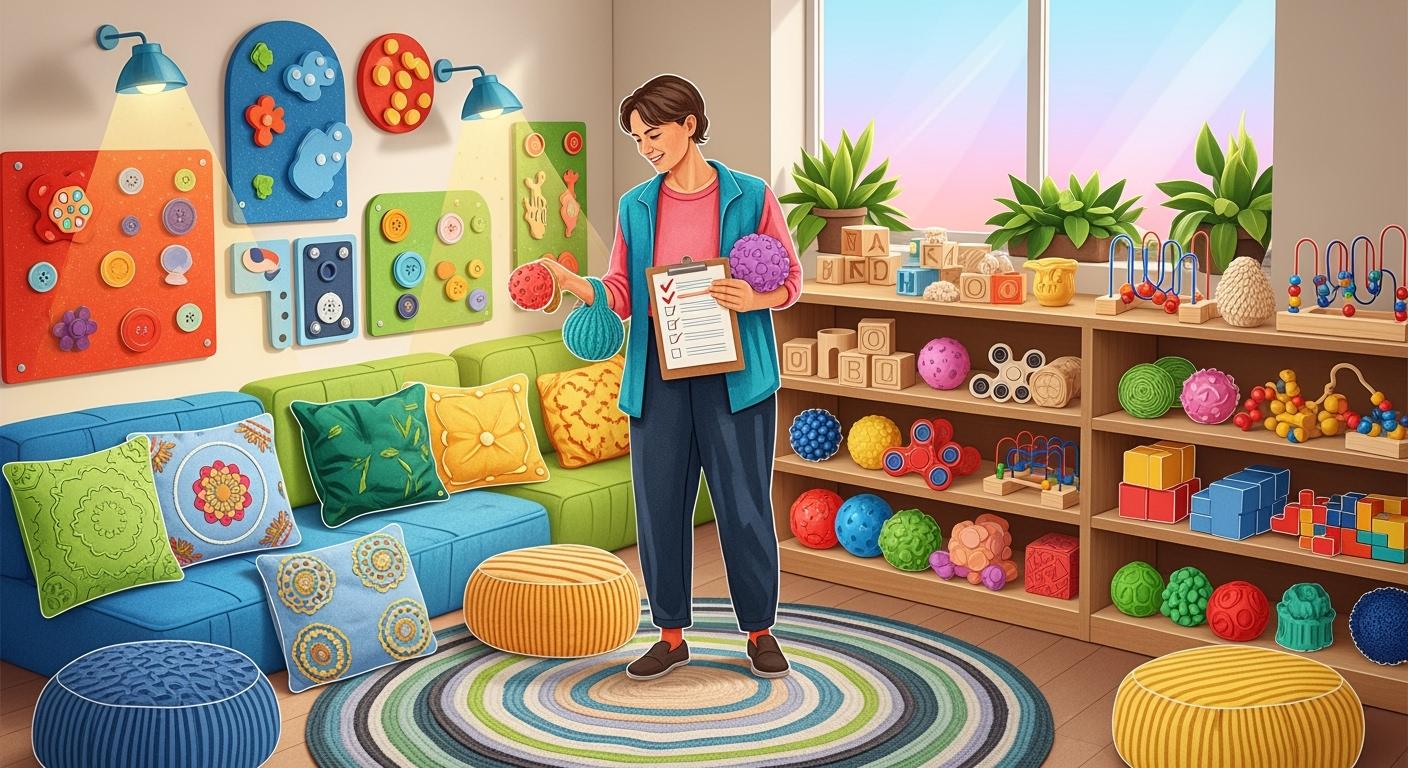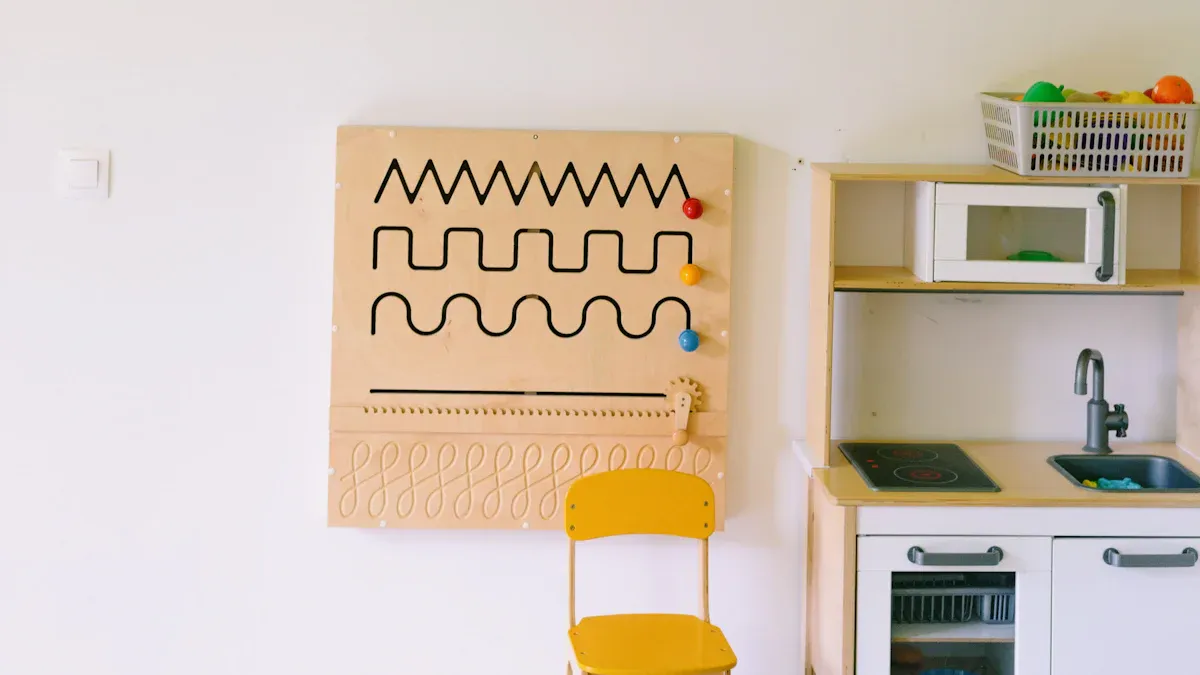Key Issues to Watch for in Sensory Room Planning

You want each child to feel safe and cared for in a sensory room. This is very important for children who have special challenges, like autistic children. Many parents see good changes. Over 78% say sensory interventions work very well. Also, 80% see their children get more involved. But, there can be problems. Sometimes, rooms do not fit each child’s sensory needs. Equipment can also be different or not the same every time. Brands like Leemoland give solutions. They help you make a space where every child can do well.
Key Takeaways
Learn about each child's special sensory needs. Use tools to find out what helps them most.
Work with teachers, therapists, and families. Their ideas help make a sensory room that fits all kids.
Make the room with clear areas for different things. This helps kids pick what they need. It also makes the room safer and more fun.
Put safety first and follow the rules. Use safe materials and make sure the room is good for all kids.
Plan for changes. Pick furniture and equipment that can be used in different ways as kids get older.
Sensory Room Needs Assessment
Understanding User Profiles
You want your sensory room to work for every child. First, learn about the children and what they need. Every child is different. Some kids like bright lights and loud noises. Others want quiet places and soft things to touch. If you do not know these differences, your room may not help all kids. This is extra important for autistic children. They can be more sensitive to sounds or lights. Some may react strongly to these things. You can use special tools to find out what each child needs. Here are some tools you can use:
Assessment Tool | Description |
|---|---|
Diagnostic Interview for Social and Communication Disorders (DISCO) | A clinical interview that looks closely at sensory symptoms. |
Sensory Profile 2 | A caregiver report with 86 questions about sensory processing. |
Short Sensory Profile (SSP) | A 38-question survey about how kids react to sensory input. |
Sensory Experiences Questionnaire (SEQ version 3.0) | A short caregiver report for kids ages 5 months to 6 years. |
Customization for Autistic Children
Autistic children have needs that are not always the same as other kids. Some like to touch soft things or move a lot. Some do not look at people or answer sounds. You might see them rock, jump, or rub objects more. These actions show their sensory needs are different. Studies say autistic kids are more sensitive to sensory things. This can change how they use the sensory room. They may need extra help in class or other places. When you plan your room, remember these needs. Pick equipment that you can change for each child.
Stakeholder Collaboration
You do not have to do this by yourself. Work with teachers, therapists, and families to learn about each child’s needs. They know the kids well. When everyone helps, you can make a room that fits all kids, even those with special needs. Brands like Leemoland have many sensory toys and tools. These can help you meet the needs of autistic kids and others. By working together, you can fix problems early and make your sensory room safe and friendly for every child.
Space and Layout Planning

Room Size and Flow
You want your sensory room to feel open and friendly. The right size is important for all children. Experts say a sensory room should be at least 3 x 4 meters. This gives kids enough space to move and relax. If you have more than one child, give each about 3 meters. This way, no one feels crowded during activities.
Think about how kids will walk around the room. Clear paths help them move without bumping into things. Put big sensory equipment along the walls. Keep the middle open for moving around. This setup helps kids feel safe and free to explore.
Accessibility for All Users
Every child should feel welcome in the sensory room. Make sure the room works for kids with wheelchairs or walkers. Use wide doors and keep the floor clear. Pick sensory tools that are easy to reach and use. Leemoland has many choices for these needs.
Add signs or colored tape to guide children. These help kids know where to go and what to do. Good lighting and soft floors make the room safer and more comfortable for everyone.
Zoning for Sensory Activities
A good sensory room has different zones for different needs. You can make areas for active play, calming down, and focused activities. This helps kids pick what they need most.
Zone | Description | Activities/Tools |
|---|---|---|
Active Zone | For movement and sensory stimulation. | Gel Floor Tiles, Tents, Tumbling Mats |
Calming Zone | A quiet place for relaxation and coping. | Filtered Lighting, Sensory Seating, Weighted Products, Soothing Swings |
Interactive Zone | For calming activities that build focus and social skills. | Yoga Spinner Game Kit, Yoga Deck for Kids |
Tip: Always make sure equipment is safe and watch children during activities. Start with gentle moves and use signs for smooth changes.
When you design your sensory room with clear zones, you help kids find the right activity for their needs. This makes the room safer, more fun, and easier for everyone to use.
Budget and Resource Management
Cost Estimation
When you plan a sensory room, think about your budget first. The cost can be very different for each room. Some rooms cost a few hundred dollars. Others can cost up to $100,000 in schools or clinics. In Europe, some rooms cost between 3,000 and 30,000 euros. You want to use your money in the best way. Do not buy too much equipment at once. Do not pick cheap items that break fast. Trusted brands like Leemoland give you good value. They also offer support that lasts a long time for children.
Prioritizing Sensory Equipment
Pick sensory equipment that fits what your children need. First, look at what helps each child with sensory processing. Spend your money on things that help the most kids. Choose items that give you the best value. Here is a simple guide:
Criteria | Description |
|---|---|
Assessing individual sensory needs | Find out what sensory processing tools each child needs most. |
Cost-effectiveness | Pick sensory equipment that gives you the most benefit for your money. |
Exploring funding options | Look for grants or local support services to help buy sensory equipment. |
You can save money by using mobile sensory carts or modular equipment. Try to use things you already have. You can also make simple DIY projects. Leemoland has many sensory tools for different budgets. Their products help all children with sensory processing.
Maintenance Planning
It is important to keep your sensory room clean and safe. Clean the room often so children stay healthy. Check equipment often to find problems early. For bubble tubes and screens, empty and refill them every 6-8 weeks. Use antibacterial wipes on soft play items. Ask children to take off their shoes to keep things clean. Clean panels and switches often. For water beds, add conditioner and get help from experts if needed. Good care keeps your sensory room safe, fun, and ready for every child.
Sensory Balance and Overload

Avoiding Overstimulation
You want kids to feel safe and happy in the sensory room. Sometimes, too many sensory activities can be too much. This is hard for autistic children. You might see signs like worry, anger, or pulling away. These signs mean the child’s needs are not being met. If a child looks upset or leaves the group, change the activity. You can use a checklist to spot overload:
Feeling worried during sensory activities
Getting angry or having mood swings
Leaving group sensory activities
If you watch for these signs, you can stop overload early. This helps kids stay calm and feel better.
Calming Environment Design
A calm sensory room helps autistic children a lot. Swings and fidget toys help kids use their energy. Quiet areas give kids a place to rest if they feel too much. Lighting is important. Soft white bulbs or LED lights that look like sunlight are best. Do not use fluorescent bulbs because they can make things worse. Pastel and blue colors make the room calm. Sensory bubble tubes and fiber optic lights add soft movement and color. Weighted items and swings help kids relax and feel calm.
Tip: Use sensory walls with soft colors, gentle textures, and quiet sounds. These things help autistic children feel safe and comfortable.
Adjustable Sensory Tools
Your sensory room should work for many needs. Adjustable sensory tools let you change things for each child. You can give kids different textures to touch, like smooth or rough. Sensory stations let kids pick what they want to feel. Tactile paths and sensory gardens give new ways to play. Sensory seats and furniture with different textures help kids relax. Fidgets and tactile toys help with sensory play and stop overload. Visual supports and labels help autistic children find what they need. Always ask kids and staff for ideas to make the room better.
When you use adjustable sensory tools, you make activities safer and more fun. You help every child avoid overload and enjoy a calm space.
Safety and Compliance in Sensory Rooms
DIY Risks vs. Professional Standards
You may want to build a sensory room yourself to save money. Sometimes, this can work. But you must think about safety first. If you skip steps, kids can get hurt. Experts use rules to stop accidents. Look at this table to see what they check for:
Addressed By Professional Standards | |
|---|---|
Electrical risks | Proper installation and adherence to safety regulations |
Trip hazards | Staff training and secure installation of equipment |
Non-fire-retardant materials | Use of materials that meet safety regulations and standards |
Following expert rules keeps kids safe. It also makes sure your sensory room follows all safety rules.
Safe Materials and Equipment
You want every child to feel safe in the sensory room. Picking safe things is very important. Here are some things to remember:
Pick fabrics that do not cause allergies
Do not use small parts that kids could choke on
Store small items safely so kids cannot reach them
Clean and check all items often
Make sure every item is right for the child’s age. Look for labels that show your equipment is safe. Using safe things lowers risk and makes the room better for kids.
Meeting Regulations
You must follow rules when making a sensory room. These rules help keep kids safe. Staff need to learn new safety tips every year. You should write down each time the room is used. Staff must know what to do if there is an emergency.
Safety Measure | Description |
|---|---|
Staff Training | Annual professional development on sensory room usage |
Documentation | Required for each instance of sensory room use |
Emergency Interventions | Training on behavior management practices, including emergencies |
If you follow these rules, you keep kids safe. Your sensory room will be a safe place for everyone.
Staff Training and Support
Training for Sensory Room Use
You want students to feel safe in the sensory room. Staff need training to help students. When staff know how to use the room, students do better. You do not need fancy tools to help kids. You just need to know how to use what you have.
Staff must learn how to use the room and equipment. Good training stops chaos and helps staff use things the right way. It matters more how you use the space than what is in it.
You can join workshops or take online classes. These teach you about sensory integration and calming ideas. You learn how to spot overload in autistic children. You also learn ways to make the room calm for everyone. Training helps you feel ready to help all students.
Guidance for Autistic Children
Autistic children need extra support. You can help by learning about their sensory needs. Some kids need to move more. Others need quiet time. Calming tools like weighted blankets, fidget toys, or soft lights help students relax.
You can use visual schedules to show what happens next. This helps autistic children feel calm and ready. Talk with families to learn about each child’s needs. Working together helps students feel welcome and included.
Ongoing User Support
You want students to keep learning in the sensory room. Ongoing support helps everyone do well. Here are some best practices:
Training and resources help staff make sensory-friendly spaces.
Families help design rooms that fit many needs.
Visual schedules and sensory kits give steady support.
Staff should keep learning new ways to help students.
Check in with students often. Ask how they feel. Change activities if needed. Update your training to learn new ways to help autistic children. Steady support helps students build skills and enjoy a calm space every day.
Flexibility and Future-Proofing
Adaptable Room Design
You want your sensory room to change as students grow. An adaptable room lets you move things when needs change. Mobile furniture is easy to push or pull for new activities. You can change the lighting to make the room calm or bright. Zoning helps kids pick a quiet spot or a place to move.
Adaptation Feature | Benefits |
|---|---|
Mobile Furniture | Move things fast for new activities or needs. |
Adjustable Lighting | Change brightness and color to set the mood. |
Zoning Areas | Make different spots for different activities. |
You can use colored panels, fiber-optic lamps, or wall projectors. These tools help make the room calm for many sensory needs.
Tip: Think about lighting, temperature, and sound. These things help your room change as kids grow.
Planning for Changing Needs
Kids change quickly. What works now may not work next year. Pick flexible seats and keep the room tidy. Dimmable lights and soft walls help control the space. Let kids help pick their favorite seats or tools. This makes them feel in charge and more comfortable.
Strategy | Description |
|---|---|
Reducing Overwhelming Stimuli | |
Flexible Seating Arrangements | Give many seat choices for different ways to learn. |
Visual Clarity | Use soft colors and keep things neat for better focus. |
Planning for change helps kids feel safe and ready to learn.
Easy Updates with Leemoland Solutions
You want updates to be easy. Leemoland makes this simple. Their modular products let you move and change things fast. Listen to kids and change the room if needed. Check the room each month to keep it safe and fresh.
Leemoland’s flexible design helps you meet new needs without starting over. This saves time and money. Kids feel in control, so they handle feelings and make friends. Studies show sensory rooms like this help kids feel better, worry less, and learn more.
Note: A flexible sensory room gives kids a safe place to explore, relax, and grow, even as their needs change.
You want every sensory room to help all kids feel safe. Planning early and including everyone makes the room better. This helps kids with autism and other needs. Research shows some important benefits:
Benefit | Description |
|---|---|
Promotes Self-Regulation | Kids learn to manage feelings and actions. |
Reduces Anxiety | Calm spaces help children feel less worried. |
Develops Social Skills | Group play helps kids make friends and work together. |
Improves Concentration | Kids pay attention better and follow rules. |
Addresses Difficult Behaviors | The room helps kids calm down and focus again. |
You can improve your sensory room with these ideas:
Change lighting and noise to make the space friendly.
Use clear routines so kids know what to expect.
Add breaks and quiet spots for comfort.
Work with families and teachers to help every child.
Leemoland gives you safe and flexible choices. When you plan early, you help kids grow, learn, and feel happy each day.
FAQ
What is a sensory room?
A sensory room is a special space where you can explore sights, sounds, and textures. You use it to relax, play, or focus. It helps kids with autism and other needs feel calm and safe.
How do I choose sensory equipment for my room?
You start by looking at what each child likes and needs. Pick tools that help with touch, sound, or movement. Brands like Leemoland offer many options for different sensory needs.
Can I set up a sensory room on a small budget?
Yes! You can use simple items like soft mats, lights, or fidget toys. Leemoland has affordable choices. You can also try DIY ideas or use things you already have.
How do I keep my sensory room safe?
Check equipment often. Clean surfaces every week. Use safe materials and store small items out of reach. Train staff to spot risks. Safety helps every child enjoy the room.
Why is flexibility important in sensory room design?
Kids grow and change fast. Flexible rooms let you move furniture, change lighting, or add new zones. You can update the space easily with modular products from Leemoland.
See Also
Essential Guidelines for Creating ASD Sensory Rooms in Schools
Important Elements of Effective ASD Sensory Rooms in Schools
Best Advice for Crafting Effective Sensory Rooms in Schools
